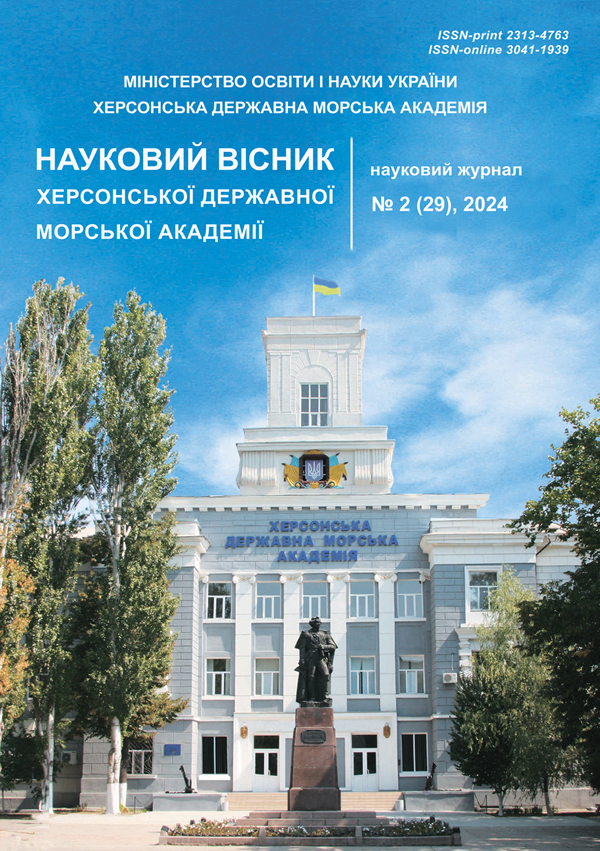SIMULATION OF THE PROCESSES OF INCREASING THE RELIABILITY OF THE NAVIGATION COMPLEX WITH THE HELP OF DUPLICATION OF ITS ELEMENTS
https://doi.org/10.33815/2313-4763.2024.2.29.164-177
Abstract
The article discusses challenges in evaluating the stability of technical systems, primarily focusing on their reliability in terms of trouble-free operation. The aim of this study is to investigate and mathematically model the enhancement of reliability through different duplication schemes in navigation system components.
Various pressing issues related to enhancing the dependability of systems through duplicating their components were discussed. Different methods for duplicating system components were assessed and their mathematical representation was developed. Research has been conducted on the feasibility of substituting the reliabilities of elements in systems with varying levels of reliability with an average value.
It was found that duplicating each element in a system of equally reliable elements is a more effective way to improve reliability than duplicating the entire system. Additionally, if the primary reliability value of the elements is 0.85 or less, duplicating the entire system with each addition of duplicate elements will greatly decrease the system's reliability. Enhancing the system's reliability through duplicating elements with low primary reliability becomes more important when element reliability is below 0.85. Also, it has been demonstrated that this substitution results in slightly higher system reliability estimates, and is only logical when there is minimal variation in the reliability values of system elements. For high dispersion values, the system reliability calculation's relative error sharply increases by more than 10%.
An instance of substantially duplicating the least dependable components of the system is shown, resulting in a more than double increase in the overall reliability of the system. Future research should focus on utilizing the concept of full probability and Bayesian probabilities for related hypotheses.
References
2. International Maritime Organization (IMO). International Convention for the Safety of Life at Sea (SOLAS), 1974.
3. Wahlström, M., Forster, D., Karvonen, A., Puustinen, R., Saariluoma, P. (2019). Perspective-Taking in Anticipatory Maritime Navigation – Implications for Developing Autonomous Ships. In Proceedings of the 18 the International Conference on Computer and IT Applications in the Maritime Industries, Tullamore, Ireland, 25–27 March 2019; 191–200.
4. Wreathall, J. (2011). Monitoring – A critical ability in Resilience Engineering. In Resilience Engineering in Practice: A Guidebook; Hollnagel, E., Paries, J., Woods, D. D., Wreathall, J., Eds.; Ashgate Pub Co.: Surrey, UK.
5. Praetorius, G., Hollnagel, E. (2014). Control and Resilience Within the Maritime Traffic Management Domain. J. Cogn. Eng. Decis. Mak., 8, 303–317.
6. Praetorius, G. (2014). Vessel Traffic Service (VTS): A Maritime Information Service or Traffic Control System? Understanding Everyday Performance and Resilience in a Socio-Technical System under Change. Ph.D. Thesis, Chalmers University of Technology, Gothenburg, Sweden.
7. Schröder-Hinrichs, J.-U., Praetorius, G., Graziano, A., Kataria, A., Baldauf, M. (2015). Introducing the Concept of Resilience into Maritime Safety. In Proceedings of the 6th Resilience Engineering Association Symposium, Lisboa, Portugal, 22–25 June 2015.
8. Smith, D., Veitch, B., Khan, F., Taylor, R. (2013). Using the FRAM to Understand Arctic Ship Navigation: Assessing Work Processes During the Exxon Valdez Grounding. TransNav Int. J. Mar. Navig. Saf. Sea Transp., 12, 447–457.
9. Wahlström, M. (2019). Resilience on the seven seas: perspective-taking in anticipatory ship navigation. In Proceedings of the 8th REA Symposium Embracing Resilience: Scaling Up and Speeding Up, Kalmar, Sweden, 24–27.
10. Van Westrenen, F., Praetorius, G. (2014). Maritime traffic management: a need for central coordination? Cognition, Technology & Work, 16(1), 59–70.
11. Aven, T., Andersen, H. B., Cox, T., Droguett, E. L., Greenberg, M., Guikema, S., Kröger, W., Renn, O., Zio, E. (2015). Risk Analysis Foundations. Soc. Risk Anal.
12. Ayyub, B. M. (2015). Practical Resilience Metrics for Planning, Design, and Decision Making. ASCE-ASME J. Risk Uncertain. Eng. Syst. Part Civ. Eng. 1. https://doi.org/10.1061/AJRUA6.0000826.
13. Ayyub, B. M. (2014). Systems resilience for multihazard environments: definition, metrics, and valuation for decision making. Risk Anal. Off. Publ. Soc. Risk Anal. 34, 340–355. https://doi.org/10.1111/risa.12093.
14. Smith, D., Veitch, B., Khan, F., Taylor, R. (2015). An Accident Model for Arctic Shipping, in: Proceedings of the ASME 2015 34th International Conference on Ocean, Offshore and Arctic Engineering. Presented at the OMAE 2015, St. John’s, NL, Canada.
15. Hollnagel, E. (2011). RAG – The resilience analysis grid. In Resilience Engineering in Practice: A Guidebook; Hollnagel, E., Paries, J., Woods, D. D., Wreathall, J., Eds.; Ashgate Pub Co.: Surrey, UK.
16. Jackson, S., Ferris, T. L. J. (2013). Resilience Principles for Engineered Systems. Syst. Eng., 16, 152–164.
17. Jackson, S., Ferris, T. L. J. (2016). Designing Resilient Systems. In Proceedings of the NATO Advanced Research Workshop on Resilience-Based Approaches to Critical Infrastructures Safeguarding, Azores, Portugal, 26–29June 2016; 121–144.
18. Madni, A. M., Jackson, S. (2009). Towards a Conceptual Framework for Resilience Engineering. IEEE Syst. J., 3,181–191.
19. Woods, D.D. (2015). Four concepts for resilience and the implication for the future resilience. Reliab. Eng. Syst. Saf., 141, 5–9.
20. Sterbenz, J. P. G., Hutchison, D., Cetinkaya, E. K., Jabbar, A., Rohrer, J., Schöller, M., Smith, P. (2010). Resilience and survivability in communication networks: Strategies, principles, and survey of disciplines. Comput. Netw., 54, 1245–1265.
21. Sterbenz, J. P. G., Hutchison, D., Cetinkaya, E. K., Jabbar, A., Rohrer, J., Schöller, M., Smith, P. (2014). Redundancy, diversity, and connectivity to achieve multilevel network resilience, survivability, and disruption tolerance. Telecommun. Syst., 56, 17–31.
22. Cheng, Y., Todd Gardner, M., Li, J., May, R., Medhi, D., Sterbenz, J. P. G. (2014). Optimised heuristics for a geodiverse routing protocol. In The 10th IEEE/IFIP international conference on Design of Reliable Communication Networks (DRCN), Ghent, Belgium.
23. Feller, V. (1984). Vvedennia v teoriiu ymovirnostei ta yii zastosuvannia. (Vols. 1–2). M.: Svit.
24. Heche, F. E. (2019). Teoriia ymovirnostei i matematychna statystyka. Uzhhorod: PP «AUTDOR-ShARK».






